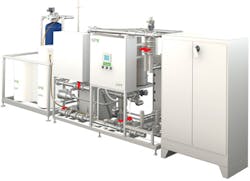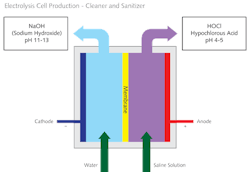Technology Provides Effective, Eco-Friendly Option for Clean-in-Place
Clean-in-place (CIP) is an important part of many processes but can add a significant amount to production costs. In numerous industries, the drive to improve efficiency while providing more flexibility to produce smaller, diversified product batches in line with consumer demands brings additional challenges to the CIP process. The time taken to carry out a CIP cycle becomes a more critical factor for overall productivity, and there are obvious higher costs associated with the increased need for cleaning and sanitizing fluids. The amount of water required and the need to handle increased, chemical-laden wastewater streams add further costs and environmental issues to the CIP process.
Nonetheless, CIP is vital for improving the efficiency of many production processes, enabling the cleaning of interior, wetted surfaces of pipes, vessels, machines, and other fittings without the need for costly and time-consuming disassembly and manual cleaning. Its arrival revolutionized industries such as food and beverage, dairy, brewing, pharmaceutical, and cosmetics, all of which require regular cleaning to ensure the highest levels of hygiene. However, consumer demands are changing, and many manufacturing plants need to produce smaller batches with varied product lines while still remaining competitive. Further, as we understand more about environmental impact and our responsibility to create sustainable production, businesses are striving towards reducing water usage, lowering carbon footprints and using ecologically-sound solutions wherever possible.
Many traditional CIP processes use hot water with caustic chemicals to ensure thorough cleaning. The CIP cycles are important not only to maintain good hygiene levels but also, when changing batch, to ensure there's no organoleptic crossover between products. For plants where these cycles are frequent, this not only uses a lot of energy and water but also can create a harsh working environment, with acrid steam, hot surfaces and the need to handle dangerous chemicals.
Technology from SPX, provided in partnership with EAU Technologies Inc., a leading provider of high volume electrolyzed water, addresses the modern needs of CIP systems. Known as SafeWater, the system produces an efficient, eco-friendly CIP fluid that can bring significant benefit to manufacturers with high CIP requirements. Generated from water and salt, SafeWater can reduce changeover times between products by up to 75 percent compared with alternatives that use caustic chemicals. The cost per CIP cycle is also lower, and the system further offers significant savings in water consumption and energy usage. The system provides equivalent or better cleaning performance compared with alternative methods and, as the name indicates, improves the working environment and greatly reduces safety risks for personnel.
The SafeWater technology produces a cleaning and/or sanitizing agent through the electrolysis of a solution of sodium chloride (common salt) or sodium carbonate (washing soda). A dividing membrane between the electrodes results in two separate solutions suitable for sanitation and CIP mainly consisting of hypochlorous acid (HOCl) and sodium hydroxide (NaOH). HOCl is a weak acid but a powerful and natural sanitizer also produced by the human body. It sanitizes rapidly without the need for heating and, as it is produced from readily-available, natural materials, it offers a highly sustainable sanitation and cleaning solution. NaOH gives the liquid a large intrinsic cleaning and saponification potential owing to its large negative reduction potential (ORP), despite relatively low concentrations of caustic.
The system uniquely generates fluids at the required concentration with no mixing or dilution required. Without the need to add dilution water, it provides superior cleaning and sanitizing as every drop of the solution has been electrolyzed. There is no need to purchase, stock or handle dangerous disinfection chemicals.
SafeWater is ideal for producers who use a lot of CIP fluid. It is made on-site using a plate generator system capable of continuous production in large volumes. The volume produced matches the plant requirements at any particular time, eliminating waste production and significantly reducing the amount of water used. The cleaning and sanitizing agents are highly effective at ambient temperature, so no additional energy is required to heat the fluids.
Whether treated in-house, by a third party or discharged to the sewer with associated surcharges, the costs of handling contaminated wastewater can represent large overhead to a business. SafeWater offers the potential to reduce these costs as it reduces the volume of wastewater produced from CIP processes. Using only natural ingredients, it's an ecologically-kinder solution, often completely negating the need for dangerous disinfection chemicals, and the fluid is quickly neutralized upon contact with organic materials on the way to or at the wastewater treatment plant.
Given the increasing frequency of CIP and criticality of plant production time to a business, the ambient, superior cleaning and microbiological performance of the SafeWater fluid will typically reduce CIP cycle times by more than 50 percent, and, in some cases, a 75 percent reduction has been realized. This can substantially impact plant productivity and can further ensure that any seasonal peaks or ‘just-in-time' production strategies can be realized more effectively and efficiently.
The return on investment (ROI) for the use of SafeWater technology depends upon the application and volumes of CIP fluid required. But as an example, in the carbonated drinks industry, the system has been used to replace conventional sodium hydroxide and nitric acid cleaning solutions and has shown an ROI of just four months.
The use of a natural, ambient CIP fluid also offers a great deal of benefit to health and safety: there are no hot surfaces, and operators have no need to handle caustic chemicals. The system is also fully automated, making it a simple and easy process requiring less operator interaction.
The SafeWater technology is a revolutionary approach to CIP and presents a sustainable, environmentally-friendly alternative to the use of harsh, dangerous chemicals. By matching the plant demands at any given time, it can offer typical savings in water usage of between 30 and 50 percent. The reduced wastewater stream it produces is safer, easier to treat and offers additional savings in production costs. As companies strive to remain competitive while meeting changing consumer demands, regulatory standards and their own goals for social responsibility, this new technology offers a practical, efficient, safe, and cost-effective solution for CIP.



